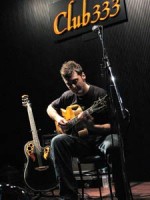Title
I had the opportunity to travel to Japan this past December 6 through 24, on a debut tour. I was the first artist signed and recorded in the summer of 2006 to Late Set records, a new American division of Spice Records, a large Japanese independent label. After my first year in Juilliard’s master’s degree program in jazz (and after allowing Late Set to settle in, business-wise), things were in place for me to tour, debuting the release of my CD, Through My Eyes, at an array of venues.
Body
I had six weeks to prepare—brief by international touring standards. I organized getting work permits and putting together my musical presentation. I traveled then with my friend and colleague Atsu Nitta, the A&R man in America who got me signed, and a New York-based saxophonist named Patrick Cornelius. Patrick and I evolved a musical friendship collaborating at my weekly gigs at the Bar Next Door, downstairs at La Lanterna di Vittorio on MacDougal Street, on Sunday nights for the last year. In Japan, we were to end up being grouped with local rhythm-section players, who would have to learn my original music in one or two rehearsals—not always easy.
I’d never traveled quite so far from home. Yet, coming from my native New York City, I never thought I’d find a place more advanced or cosmopolitan, considering our city’s history and the millions who’ve flocked here from around the globe.
But Japan was spectacular: incredibly modern, creative, and advanced. The sheer spread of Tokyo was enormous. Arriving at Tokyo-Narita Airport after my first 14-hour flight, we were greeted by new friends from Spice Records. They brought us into the city that night. We passed a huge Ferris wheel lit in red that stood not far from the massive and exquisite Rainbow Bridge, a longer, more modern, sinewy version of the Verrazano. The bridge led to the brash modernity of Tokyo’s skyline. Lights were brighter, more colorful, buildings more numerous and tighter, streets narrower than anything I’d seen at home. It felt like Blade Runner.
Tokyo’s architectural and population density was uniquely balanced by a clear sense of order. Cars and pedestrians abided dutifully by laws and strong social etiquette. Metros were immaculate, on time. Swarms of people moved silently through Shibuya area streets, a cross between Times Square and Greenwich Village. Even bento-box meals prepared at the train station were presented with their own aesthetic. Intimate meals at sushi bars or soba shops were amazing. Public facilities were immaculate and there was no garbage anywhere. This New Yorker was blown away.
The Japanese displayed their aesthetic and style in fashion as well—in tailored elegance, rock star glitter, or hip-hop threads. School kids riding the metros wore World War II-inspired navy uniforms, as did metro workers and cabbies (along with white gloves).
I played a solo show at an intimate, bohemian room called Casa Classica, then a duo gig with Patrick at Tokyo Tower, a reinterpretation of the Eiffel Tower decorated in red lights. It was exciting to rock out my electronic loops to passers-by who gathered for my show, high above the glowing city. I felt particularly happy to see teens who looked so intrigued and excited. I played club gigs and concerts at JZ Brat in Tokyo, Kamome in Yokohama, at B-Roxy (a bullet-train ride away in Osaka), plus another gig at a beautiful, open-air modern-art museum in the mountains of Hakone.
I did a special event for the 80th anniversary of the Tokyo metro. My live music accompanied a runway fashion show full of wedding dress-clad, beautiful Japanese models. Passers-by seemed quietly overwhelmed by the Western-inspired fashions presented in a ritual Asian way. I was happy when loud, excited cheers broke the silence of the audience, following my set.
My music fused American jazz with rock, classical, folk, and electronica. Thus, in a culture where audiences’ expectation was for more traditional jazz, I felt challenged to play my music with vigor and conviction. The audiences focused their attention generously, whether it was listening to my music or my stage chat in English. I deeply appreciated the English words they found (like “beautiful harmonies”) to compliment it. “Domo,” I said. “Domo arrigato,” expressing my thanks to them.
The Japanese jazz players I heard were blissed out on classic jazz and its visceral qualities. Perhaps as release from the emotional boundaries of Japanese society, they were quick to go for jazz’s loudest, grittiest passages, be it a high screech, a blue note, a bashing band crescendo, or a grand finale-style, smashing ending. What the music hadn’t found yet, I felt, was the ease, the extensive vocabulary that truly defined the melodic intricacy and deep swing of great classic jazz. This seemed unexpected for a society so culturally tuned into totally digging American jazz.
On the plane ride home, I listened to Joe Henderson on my iPod. He served up the intensity, intellect, grit, and soul that are New York—to me, a bittersweet place of creativity, diversity, struggle, and unrest. I’m left wondering where my future will lead me and where my music will take me. I was happy in beautiful Japan, dreading somewhat my return to the grind of the place that made me who I am—strangely, the place that made all this possible. But, as I have many times when facing fears, including the first time I walked through the doors of Juilliard, I simply told myself, “Forward!”





